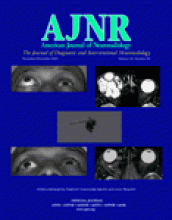Research ArticleINTERVENTIONAL
Histopathologic and Immunohistochemical Comparison of Human, Rabbit, and Swine Aneurysms Embolized with Platinum Coils
Daying Dai, Yong Hong Ding, Mark A. Danielson, Ramanathan Kadirvel, Debra A. Lewis, Harry J. Cloft and David F. Kallmes
American Journal of Neuroradiology November 2005, 26 (10) 2560-2568;
Daying Dai
Yong Hong Ding
Mark A. Danielson
Ramanathan Kadirvel
Debra A. Lewis
Harry J. Cloft

Submit a Response to This Article
Jump to comment:
No eLetters have been published for this article.
In this issue
Advertisement
Daying Dai, Yong Hong Ding, Mark A. Danielson, Ramanathan Kadirvel, Debra A. Lewis, Harry J. Cloft, David F. Kallmes
Histopathologic and Immunohistochemical Comparison of Human, Rabbit, and Swine Aneurysms Embolized with Platinum Coils
American Journal of Neuroradiology Nov 2005, 26 (10) 2560-2568;
Jump to section
Related Articles
- No related articles found.
Cited By...
- Fucoidan-coated coils improve healing in a rabbit elastase aneurysm model
- An in vitro model for Extracellular DNA Traps (ETs)-rich Human Thrombus Analogs
- Aneurysm healing after endovascular treatment in the Helsinki sidewall aneurysm model: a systematic review
- Rabbit Elastase Aneurysm Model Mimics the Recurrence Rate of Human Intracranial Aneurysms following Platinum Coil Embolization
- An in vitro model for Extracellular DNA Traps (ETs)-rich Human Thrombus Analogs
- WEB Device Shape Changes in Elastase-Induced Aneurysms in Rabbits
- Downstream vascular changes after flow-diverting device deployment in a rabbit model
- Assessment of endothelialization of aneurysm wall over time in a rabbit model through CD31 scoring
- Rabbit aneurysm models mimic histologic wall types identified in human intracranial aneurysms
- Autologous adipose-derived mesenchymal stem cells improve healing of coiled experimental saccular aneurysms: an angiographic and histopathological study
- From bench to bedside: utility of the rabbit elastase aneurysm model in preclinical studies of intracranial aneurysm treatment
- Characterizing patterns of endothelialization following coil embolization: a whole-mount, dual immunostaining approach
- Evaluation of the Angiographic Grading Scale in Aneurysms Treated with the WEB Device in 80 Rabbits: Correlation with Histologic Evaluation
- Gene expression comparison of flow diversion and coiling in an experimental aneurysm model
- Immunohistochemical analysis of a ruptured basilar top aneurysm autopsied 22 years after embolization with Guglielmi detachable coils
- Mechanisms of Healing in Coiled Intracranial Aneurysms: A Review of the Literature
- Correlation of thrombus formation on 7 T MRI with histology in a rat carotid artery side wall aneurysm model
- Immunohistochemical analysis of a ruptured basilar top aneurysm autopsied 22 years after embolization with Guglielmi detachable coils
- Creation of sidewall aneurysm in rabbits: aneurysm patency and growth follow-up
- Healing of saccular aneurysms following platinum coil embolization: lack of improved efficacy with vitamin C supplementation
- Creation of Bifurcation-Type Elastase-Induced Aneurysms in Rabbits
- 1-Hexyl n-cyanoacrylate compound (Neucrylate™ AN), a new berry aneurysm treatment. II. Rabbit implant studies: technique and histology
- The Woven EndoBridge: A New Aneurysm Occlusion Device
- Improved Microsurgical Creation of Venous Pouch Arterial Bifurcation Aneurysms in Rabbits
- Creation of Large Elastase-Induced Aneurysms: Presurgical Arterial Remodeling Using Arteriovenous Fistulas
- Five-Year Follow-Up in Elastase-Induced Aneurysms in Rabbits
- In Vivo Experimental Intracranial Aneurysm Models: A Systematic Review
- Intrinsic Pathway-Mediated Apoptosis in Elastase-Induced Aneurysms in Rabbits
- Morbidity and Mortality Associated with Creation of Elastase-Induced Saccular Aneurysms in a Rabbit Model
- Endovascular Histologic Effects of Ultrathin Gold- or Vitronectin-Coated Platinum Aneurysm Coils in a Rodent Arterial Occlusion Model: A Preliminary Investigation
- Molecular Indices of Apoptosis Activation in Elastase-Induced Aneurysms After Embolization With Platinum Coils
- Endovascular Treatment of Aneurysms: Healing Mechanisms in a Swine Model Are Associated with Increased Expression of Matrix Metalloproteinases, Vascular Cell Adhesion Molecule-1, and Vascular Endothelial Growth Factor, and Decreased Expression of Tissue Inhibitors of Matrix Metalloproteinases
This article has not yet been cited by articles in journals that are participating in Crossref Cited-by Linking.
More in this TOC Section
Similar Articles
Advertisement











